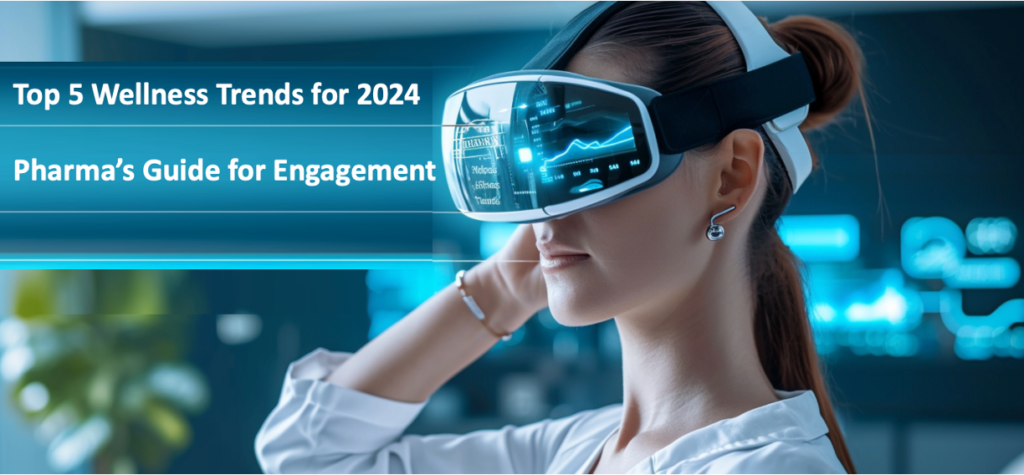Top 5 Wellness Trends for 2024: Pharma’s Guide for Engagement

Introduction
As we usher in 2024, the pharmaceutical industry stands at the forefront of a transformative era in healthcare and wellness. The landscape is evolving rapidly, driven by technological advancements, changing consumer behaviors in the post-Covid world, and a deepened understanding of health and wellness. For pharmaceutical companies and industry professionals, comprehending and navigating these changes is not just an opportunity but a necessity to stay relevant and contribute meaningfully to global health trends.
The year promises to be a pivotal one, marked by an array of wellness trends that are reshaping patient expectations and healthcare delivery. These key trends are not just passing fads; they represent a fundamental shift in how individuals approach their health and how healthcare providers, including pharmaceutical companies, must respond to these needs. From the digitalization of health services to a renewed focus on mental wellness, and sustainable healthcare solutions, each trend underscores a unique aspect of the healthcare journey.
In this blog, we will explore the Top Five Wellness Trends for 2024, offering an overview of each trend and its implications for the pharmaceutical industry and patient engagement. Our aim is to provide a practical roadmap for industry professionals to navigate this exciting and challenging terrain, ensuring that they are well-prepared to meet the demands of 2024 and beyond.

- Digital Health Expansion
The pharmaceutical industry is continuing to adapt to the digital health revolution, which includes telemedicine, wearables and online health services. While Generative AI captured the headlines in 2023, the overall trend in 2024 will continue reshaping patient engagement and access to care, offering new platforms for patient education, medication management, and next level patient monitoring. Meanwhile, on an individual level, patients are integrating digital wellness tools and apps into their lives like never before. These trends are opening the door to truly new levels of patient engagement and treatment.
For pharma companies, developing a portfolio of collaborative digital partners has proven to be a viable strategy for navigating the fast-moving space. Digital leader AstraZeneca has more than 30 collaborations, 28% of which directly contribute to drug development. AstraZeneca has also been using advanced data marketing platforms to accelerate trial recruitment. Meanwhile, Otsuka – another digital pioneer is exploring AI-driven ventures and leveraging Patient Outcome Data.
Another nascent trend is for well-known consumer behavorial apps to begin offering medications to support their patient results. Noom has been working closely with Novo Nordisk for several years, and in 2023 launched Noom Med. Along with GLP-1s — Novo’s Wegovy, Saxenda and Ozempic and Lilly’s Mounjaro, the program will also offer cheaper medications such as Currax Pharmaceuticals’ Contrave, which reduces food cravings, and metformin, a generic diabetes drug that’s also used for weight loss. - Mental Wellness Integration
With a continuous focus on mental health, there is a growing need for pharmaceutical companies to integrate mental wellness into their product offerings. This involves developing medications that address mental health conditions and also supporting holistic digital approaches.
Towards that end, Boehringer Ingelheim is working with Click Therapeutics to enroll about 430 participants across the U.S. who will go through a four-month program that combines Click’s smartphone app-based digital therapeutics with standard-of-care drug therapies in schizophrenia. The study is aimed at treating what are termed as the “negative symptoms” of schizophrenia among adult patients—that is, symptoms that take away from a person’s life such as disabling losses of emotion or interest, or withdrawing from social situations. “The CONVOKE study not only advances precision psychiatry by marrying personalized digital interventions with standard of care psychopharmacology, but also aims to help solve this key cause of disability for the millions living with schizophrenia,” said Shaheen Lakhan, MD, PhD, FAAN, Chief Medical Officer of Click Therapeutics. - Sustainable Healthcare Solutions
Environmental concerns are increasingly influencing consumer choices. Pharma companies are now expected to adopt sustainable practices in drug production and packaging, aligning with the broader trend of eco-consciousness in healthcare.
Some of the noteworthy industry efforts: Abbott designed its latest continuous glucose monitor (CGM) sensor, FreeStyle Libre 3, with sustainability in mind, significantly reducing its plastic use and packaging size. Meanwhile, Amgen is building a sustainable biomanufacturing plant in New Albany, Ohio, which includes solar panels and energy-efficient technology. - Nutraceuticals and Functional Foods
The line between food and medicine is blurring, with more consumers turning to nutraceuticals and functional foods for health benefits. This is a growing global trend:
* Yakult 1000, a probiotic dairy drink by Yakult Honsha, launched in Japan, claims to alleviate stress, improve sleep quality, and regulate intestinal function.
* Sweden-based Probi has launched Probi Sensia, a probiotic targeting mood, sleep, and stress.
* General Mills is rolling out its Good Measure snack brand, and NotCo, a plant-based business backed by Jeff Bezos, has launched a bar designed to regulate blood glucose.
Clearly this represents a large opportunity for pharmaceutical companies to expand into these markets, offering products that complement traditional medications. - Virtual Reality in Healthcare
After years of hype, virtual reality (VR) is finally emerging as a practical tool for both therapeutic applications and patient education. VR is increasingly used in healthcare for conditions like anxiety, PTSD, and autism. The recently launched Apple Vision Pro, with its mixed reality format, allows for virtual reality and augmented reality applications – making it especially useful in health and wellness settings.
For example, Hoag Hospital in California used a VR medical imaging platform for brain surgery rehearsal and found it beneficial for patient confidence. They also trialed VR across departments and used it in their chemical dependency programs. In similar fashion, pharmaceutical companies are starting to explore VR to enhance patient experiences, from providing immersive educational content to supporting mental health therapies. Mixed reality VR is also being used to amplify KOL messaging and create immersive MOA experiences for both patients and HCPs.
In conclusion, these Top Five Wellness Trends for 2024 reflect a dynamic healthcare landscape where patient needs and preferences are rapidly evolving, driven by a post-Covid move towards wellness and healthy living. Pharmaceutical companies must adapt to these changes, not only to stay relevant but also to play a pivotal role in shaping a healthier future. By understanding and responding to these trends, the pharmaceutical industry can develop strategies that are both patient-centric and forward-thinking.
We welcome your feedback and additional insights on these trends.
Please share your thoughts at [email protected].





